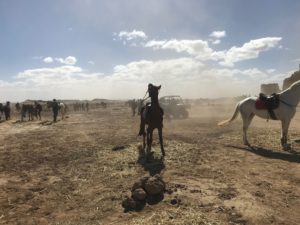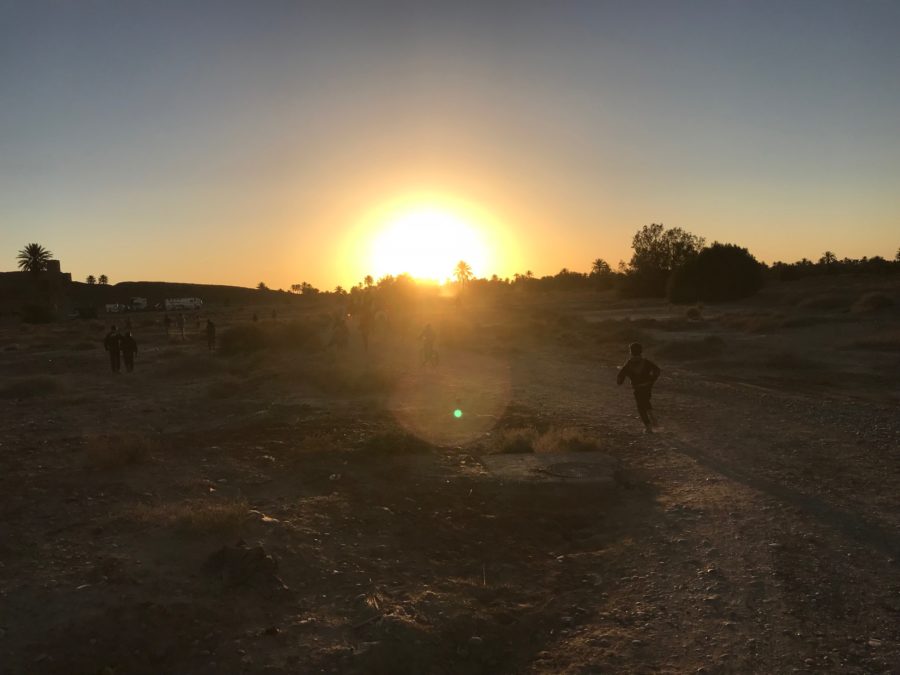2nd May 2018 Morocco, Rabat
A Moroccan Road-Trip

Behind us the mayhem of bucking and rearing horses and their falling riders continued unabated – the wind kicking up their tempers as easily as it picked up the fine dust of the Sahara. In front of us, Leah and her team slowly rode into the swirl of the sand-storm. Until, like half-imagined phantoms, they disappeared from view, leaving nothing but a blacker darkness in the desert dust. Their amazing, six- day odyssey across the desert sands of Merzouga had begun.
The night before it had all been so different – the calm before the storm. Dozens of horses pegged to their stakes in the ground. The air alive with their neighs and calls. The only dust visible, that kicked up by their moving feet. The sun had set gracefully behind the desert castle, creating wonderful palm-tree silhouettes and casting ever-lengthening shadows of the half-ruined walls out across the desert. We had watched as the riders of the Moroccan teams on their last practice session emerged into view, rising out of the stillness and heat-haze of the desert floor and solidifying into the reality of Leah and her riding companions. The sense of excitement and anticipation for horse and rider was almost so strong, it was almost palpable.

Leaving Leah to her devices and the tender mercy of her beautiful but wayward horse, we set off back from Erfoud towards Rabat. As we drove, I thought of the journey we had already made. From Rabat across the plains to Marrakesh. So much has been written about that pink-built, beguilingly, enchanted city, set in the shadows of the towering Atlas mountains, now gracefully crested with their crowns of white that further words would be redundant. From Marrakesh we wove up into the mountains themselves: a wondrous, sinuous route. Winding, doubling-back. And climbing, always climbing. At times the road clung to the outside edge of the mountain, like a snake wrapped around the branch of a tree. At other times, it seemed as much part of the geography as the hillside itself. Lorries chugged up the other way. The road seemed impossibly narrow. We held our breath and they slipped on past in a cloud of diesel fumes and screaming gears.
Over and down to Glaoui territory: the last Lord of the Atlas, supporter of the French; dominator of these lands for over half a century, before independence wrought his ruin. And on to Ourzazate: home of the Moroccan film industry. Dozens of films have been shot here (including my all-time favourite, Gladiator). And you can see why. The scenery is brutal and beautiful. The Atlas force the Atlantic winds upwards, dropping their moisture as snow. The plains on the North of the Atlas are verdant; those to the South are barren and dramatic, rising upwards to the majesty of those snow-capped peaks.
And where the melt-waters flow, verdant valley oasis grow. The Valley of the Roses. Date-palms. Fruit trees. Cherries and pears. An unexpected garden of Eden. The road wound along it and so, therefore, did we.
And in village after village and in the gaps between, we watched as women struggled up banks and staggered along the road, bent-double under the loads of sticks and logs they carried on their back, gathered from the orchards ready for burning at night to heat their houses – for it was cold at night, a biting wind blowing down out of the North. Women, always women, leading donkeys, almost invisible under their loads of grass or sticks or other necessary burdens. The men appearing only in towns where they gathered in cafes to watch TV, play draughts, smoke cigarettes and drink coffee.
Of the two most awesome gorges: the Todra and the Dades, we had time only to explore Dades, where exactly 19 years before my sister and I had stayed on our peregrinations around Morocco. There were parts of the drive along the valley that I recalled. The road winding its way first along the valley floor, before climbing in the most dramatic, snaking manner to a pass and then continuing to soar along high above the river, with vertiginous views down to its brown progress, hundreds of metres below. At one point, the road narrows and, for a while only single lane traffic is possible – the route hemmed in by vertical cliffs and an ever-eroding valley wall: the hillside below strewn with the wreckage of dozens of crash barriers, borne away by the decaying ground
Finally, the road disgorged into a market. The end of the line, literally. Buses and vans, impossibly over-laden, carried people on out into the untamed desert. A huge open-air market, populated by military tents and stalls. Produce lying on plastic sheeting and rickety tables by the side of the road. A real end-of-the-world feeling – like El Chalten in 2002. It was frantic, chaotic and disorderly. Cars, people, animals, , buses, produce. Horns blowing, passengers mounting and dismounting. Permanent motion in all directions: a full-on assault on the senses. Back in the valley, the normal insanity of Moroccan driving felt welcomingly pedestrian.
On we drove. Past more oasis and more date and palm trees. On towards Erfoud, past the most extraordinary irrigation tunnels, cut underground for kilometres to deliver water from the oasis to other farming communities not blessed by the immediate presence of fresh water.
The road back to Rabat was dramatic and beautiful. Some of the most challenging driving conditions I can remember in one journey. When it wasn’t the sandstorm in which we had left Leah and her team, it was blinding heat as we crossed the barren desert and began the slow wind up into the snow-clad mountains; a desperate blizzard at 2,300 metres; dense fog as we drove back down from the Atlas; slow-moving lorries, blocking both lanes as we trundled back up into the verdant Moyen Atlas; and the extraordinarily far-reaching views out towards the Rif Mountains through the gaps in the torrential rain as we descended back into the flat lands which approach the coast and Rabat.
At the end of our road trip, we had covered nearly 2,000 Kms, through the most extraordinary variety of scenery, climates and geography: a variety which would be an embarrassment of riches if divided between several countries, but crammed into one seems utterly overwhelming.
But as well as this remarkable range of natural beauty, I could not help but notice three things. Firstly, the plastic. Everywhere, the natural world seemed to lie under a layer of discarded plastic. Morocco has gone further than most countries and banned plastic bags in supermarkets, but the deadly legacy remains. I daresay the plastic contamination is no worse in Morocco than in many other countries, but the natural wonder of the scenery seems to force the pollution into a sharper contrast. The country desperately needs a recycling policy and investment in public education to change attitudes about discarding used products and encourage more recycling. Second, rural poverty. The contrast between the shoeless children wandering the streets in the Dades Gorge road and the Porches and Mercedes which roar through the streets of Rabat and Casablanca was jarring. Morocco recognises this problem and is working hard to tackle it and help the populations most in need – hence the military tents in the market. And third, the role of women in rural Morocco. Women hold communities together. They raise the children; collect the firewood; cook the meals; keep the house. And disproportionately, they are less well-educated. Failing to educate women stunts their personal development and reduces the economic potential of a country. Released, that development and potential would pay a real dividend from which Morocco can only benefit.
As Leah re-emerged from the dust and sandstorms of her desert adventure and I climbed back down from the summit of Mount Toubkal, I reflected how lucky we are to have the opportunity to live and work in a country which has so much to offer. And of how amazing it would be if we could leave it in a better condition at the end of my posting, by forming a genuine partnership between the UK and Morocco to roll-back the unwanted covering of plastic and unshackle that developmental potential.

While much has been written on this topic, your article expresses both the positive and negative aspects of this important topic, without taking an emotional stance on either side of the issue.
Great read and sentiment Thom. And it sounds like Leah had a fantastic if not challenging time!